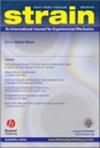数据科学辅助了AP - HTPB晶体粘结剂复合材料冲击行为的内聚有限元建模
IF 2.4
3区 材料科学
Q2 Engineering
引用次数: 0
摘要
摘要本文采用计算内聚有限元法(CFEM)模拟了高氯酸铵(AP) -端羟基聚丁二烯(HTPB)复合材料在冲击载荷下的响应,并通过跌落锤实验进行了验证。本研究通过3 ~ 10 m/s的冲击速度,检测了AP晶体尺寸在200 ~ 400 μm之间的冲击行为。基于CFEM模拟结果,利用方差分析(ANOVA)检验和响应面法(RSM)构建了模拟输入与结果之间关系的数学模型。计算和实验结果均表明,局部应变速率与晶体尺寸呈显著正相关,温度变化率与晶体尺寸和冲击速度均呈正相关。此外,刚度和压缩能是影响局部应变率和温度变化率的主要因素。RSM是模拟材料在不同实验条件下的冲击响应的有效工具。本文章由计算机程序翻译,如有差异,请以英文原文为准。
Data science assisted cohesive finite element modelling of impact behaviour of AP‐HTPB crystal binder composite
Abstract In this work, the response of an ammonium perchlorate (AP)‐hydroxyl‐terminated polybutadiene (HTPB) composite material under impact loading is presented, utilizing computational cohesive finite element method (CFEM) simulations that are validated with drop hammer experiments. This study examined the impact behaviour of AP crystal sizes between 200 and 400 μm by varying impact velocities between 3 and 10 m/s. Based on the outcome of CFEM simulations, analysis of variance (ANOVA) tests and a response surface method (RSM) were utilized to construct a mathematical model approximating the relationships between simulation inputs and outcomes. Both computational and experimental results show that the local strain rate has a considerable positive correlation with crystal size, and the rate of temperature change has positive correlations with both crystal size and impact velocity. Further, it was observed that stiffness and compression energy are the primary factors to variances in local strain rate and rate of change of temperature. RSM has been found to be an effective tool for modelling impact responses of materials under varying experimental conditions.
求助全文
通过发布文献求助,成功后即可免费获取论文全文。
去求助
来源期刊

Strain
MATERIALS SCIENCE, CHARACTERIZATION & TESTING-
CiteScore
4.50
自引率
4.80%
发文量
27
审稿时长
2.3 months
期刊介绍:
Strain is an international journal that contains contributions from leading-edge research on the measurement of the mechanical behaviour of structures and systems. Strain only accepts contributions with sufficient novelty in the design, implementation, and/or validation of experimental methodologies to characterize materials, structures, and systems; i.e. contributions that are limited to the application of established methodologies are outside of the scope of the journal. The journal includes papers from all engineering disciplines that deal with material behaviour and degradation under load, structural design and measurement techniques. Although the thrust of the journal is experimental, numerical simulations and validation are included in the coverage.
Strain welcomes papers that deal with novel work in the following areas:
experimental techniques
non-destructive evaluation techniques
numerical analysis, simulation and validation
residual stress measurement techniques
design of composite structures and components
impact behaviour of materials and structures
signal and image processing
transducer and sensor design
structural health monitoring
biomechanics
extreme environment
micro- and nano-scale testing method.
 求助内容:
求助内容: 应助结果提醒方式:
应助结果提醒方式:


